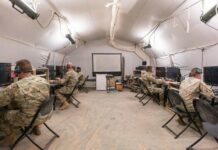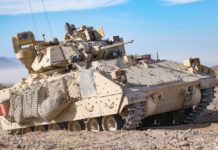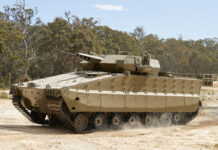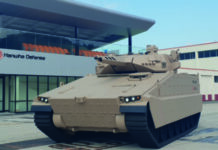The US Army’s Optionally Manned Fighting Vehicle (OMFV) programme remains on schedule and is set to enter Phase 3 in early 2023, replacing the legacy M2 Bradley Infantry Fighting Vehicle (IFV). In this sitrep, Sidney E. Dean examines the programme’s progress.
The Bradley has undergone repeated upgrades since entering service in 1981, but has now reached the limits of its growth potential. A new, modern design is needed in order to incorporate future technologies and achieve new capabilities required to retain battlefield superiority in coming decades. The OMFV will assume such classic IFV missions as battlefield infantry transport, fire support, and direct engagement of enemy vehicles.

According to an Army statement dated 28 February 2022, OMFV is “tasked to manoeuvre through the enemy’s security zone as part of a combined arms team for the purpose of creating an advantageous position, relative to the enemy, and providing protection and direct fire lethality while manned or remotely operated. In the close fight, the OMFV enables the ability of dismounted elements to manoeuvre by detecting and destroying targets at a range beyond the enemy’s capability.”
The Army expects the new vehicle to significantly outperform the M2 by providing “transformative flexibility and lethality capabilities to future battlefield commanders.” Two of these transformative attributes will be the ability to be remotely operated by a dismounted crew, and to operate seamlessly with fully unmanned Robotic Combat Vehicles (RCV) currently under development. The vehicle is also expected to mount improved sensors and weapons as well as enhanced survivability features.
OMFV is the first major ground combat vehicle development programme relying on digital engineering during the primary design phases. The programme is divided into five phases (dates refer to the US government fiscal year or FY which runs from 1 October through to 30 September):
1) Market Research and Requirement (2018–2020).
2) Preliminary Design (2021–2022).
3) Detailed Design (2023–2024).
4) Prototype Build and Test (2025–2027).
5) Production and Fielding (2027–2030).
Preliminary Design Results
The Preliminary Design phase of the programme was initiated in July 2021 with the award of contracts to five contenders. As the industry teams worked on development of digital designs utilising modelling, simulation and analysis of varying designs’ capabilities, the Army continued to flesh out its requirements. The military and the industrial teams maintained close contact, and new requirements or preferences were constantly passed on to industry to flow into the design process. All designs were formally reviewed and revised three times during the Preliminary Design Phase to ensure maximum orientation to Army priorities, which became more precisely focussed during the course of Phase 2.
The deadline for the industry teams to formally submit the completed preliminary designs was 1 November 2022. All five contestants met that deadline. The Army will review the designs over several months. Based on the results of this review, the Pentagon plans to award up to three contracts for the Detailed Design Phase (programme Phase 3) by April 2023. The Army had announced a full and open competition for Phase 3, meaning that firms which had not participated in Phase 2 would still be eligible to submit proposals. Whether any other firms chose to do so has not been made public.
The known active contenders for the OMFV programme are: American Rheinmetall Vehicles (ARV); BAE Systems Land and Armaments; General Dynamics Land Systems (GDLS); Oshkosh Defense; and Point Blank Enterprises (PBE). Given the intense feedback and interim reviews by the Army during the course of Phase 2, the designs of the five competitors became increasingly similar as the submission deadline neared.
This especially true for the hardware characteristics. All designs feature a tracked hull with hybrid diesel-electric drive, an unmanned turret mounting a 30 mm to 50 mm automatic cannon, and a vehicle crew of two (down from the Bradley’s three). Additional features include the ability to carry anti-tank guided missiles (ATGMs) as well as an integrated Active Protection System (APS) against ATGMs and RPGs. The majority of these attributes had been presented by the Army as “preferred” rather than required, but ultimately industry understood that designs not incorporating these features would be at a distinct disadvantage going into the downselect to Phase 3. One area where the Army was forced to compromise was passenger capacity. All designs can accommodate six armed infantry soldiers. The Pentagon had initially hoped to transport a complete nine-person squad in one vehicle. Ultimately the weight and size limitations for the OMFV – crucial to ensure transportability and mobility goals – turned out to be too restrictive to accommodate this objective.
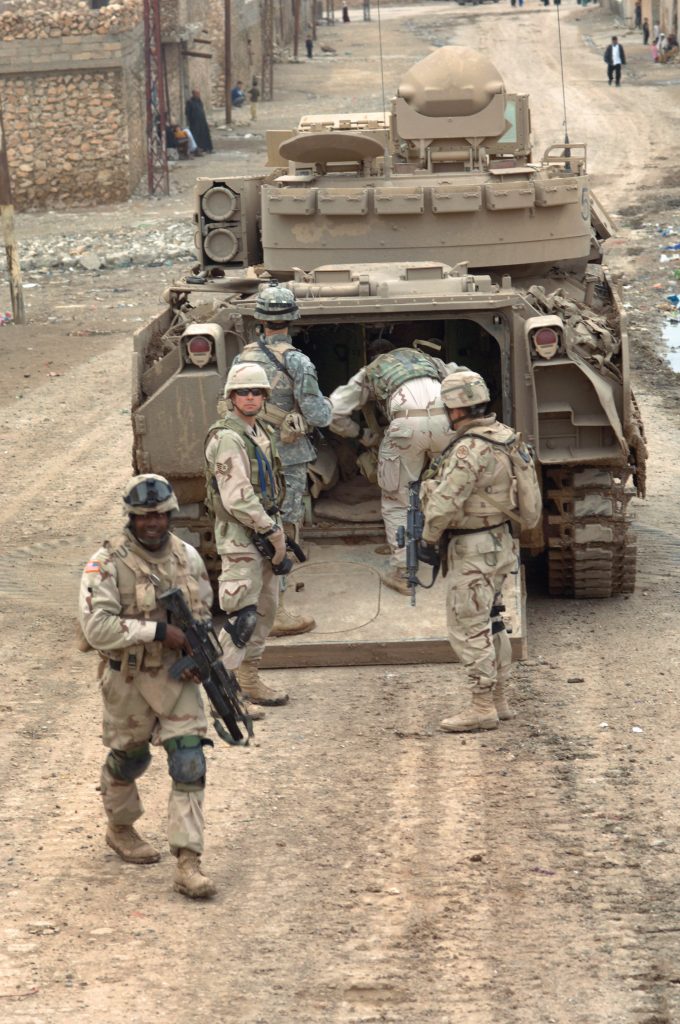
Intangible Aspects
All designs are required to meet certain criteria. One of the most critical is a Modular Open Systems Architecture (MOSA) based on Army-designed and owned standards. The relevant MOSA for OMFV and other armoured combat vehicles is the Ground Combat Systems Common Infrastructure Architecture (GCIA). To comply with this standard, each vehicle platform must feature standardised hardware, software and data interfaces which will facilitate exchange or addition of mission systems over the decades of expected service life via ‘plug-and-play’ functionality. However, the vendors’ responsibility regarding MOSA extends far beyond the interface configuration. They must ensure that each and every hardware and software component going into the OMFV is itself GCIA-compliant.
Overall, the Pentagon and the industry teams have remained fairly tight-lipped regarding details of the invisible features of their designs, such as the level of automation and artificial intelligence (AI), electronic warfare capabilities, or the precise composition of the vectronics suites. Given the reduced crew size, AI will be particularly important for enhanced situational awareness and targeting as well as navigation. Another automated capability which the Army values is predictive maintenance. The ability of onboard sensors to constantly monitor vehicle health and warn the crew before key components break down is expected to significantly boost mission availability while reducing the support burden. Military and industry personnel agree that the automation element poses the greatest challenge of the entire program. This holds from an operational standpoint (determining which functions are most suited to automation in order to relieve stress on a smaller crew, with AI effectively acting as the “third crewmember”) and from a technological standpoint (determining what is or is not currently feasible).
Another Army priority is a required margin for growth, which will permit integration of future technologies including enhanced armour, vectronics, and – potentially – jammers and directed energy weapons (DEWs). Given that OMFV is expected to serve through 2080, and that many incremental and breakthrough technological developments are expected over the coming decades, the winning designs may ultimately be those which display the greatest future growth potential.
Contenders
Given the multiple key technology areas flowing into the IFV, each prime contractor has partnered with several firms, each of which brings in special expertise in crucial areas. Details regarding their respective designs have emerged in recent months, with some firms being more open than others. Despite the overall similarities of the designs, the various prime contractors have been quick to point out special advantages presented by their own particular works.
American Rheinmetall Vehicles
American Rheinmetall, partnering with Raytheon Technologies, Textron Systems, L3Harris Technologies, Allison Transmissions and Anduril Industries, is basing its OMFV design on the KF41 Lynx IFV which is currently being acquired by Hungary. ‘Team Lynx,’ as the partners call themselves, showcased a mock-up of its OMFV at the October 2022 Association of the US Army (AUSA 2022) exhibition. The Lynx OMFV has been significantly redesigned to meet US requirements. In that context, the size and weight of the original vehicle was reduced, at the expense of cutting passenger capacity from eight to six soldiers. The OMFV also features a new, US-designed turret with a Northrop Grumman XM913 50 mm automatic cannon, a Raytheon Multi-Mission Launcher capable of deploying TOW and Javelin ATGMs, as well as Coyote loitering munitions, 3rd-Generation FLIR sights, 360° local situational awareness, and Rheinmetall’s Strikeshield APS. Raytheon describes the multi-mission launcher as unique across the market, delivering a new level of tactical flexibility. ARV has also emphasized the role of Anduril in the team, referencing the firm’s expertise in automation and AI, software development and sensor fusion.

BAE Systems Land and Armaments
BAE Systems, builder of the M2 Bradley, took a clean-sheet approach to OMFV. Its partners in the programme include Elbit Systems of America, Curtiss-Wright Defense Solutions, and QinetiQ Limited. Elbit is providing its UT50 unmanned turret armed with the XM913 50 mm automatic cannon and ATGMs. Curtiss-Wright assisted BAE with MOSA design and is collaborating on vectronics and control systems. QinetiQ is supplying the electric cross-drive transmission, based on its Modular E-X-Drive transmission, to be integrated into the hybrid electric drive which it is co-developing with BAE.

While BAE has made the same effort as the competition to minimise vehicle weight, the firm is also offering a modular add-on armour option to enhance survivability in certain high-risk warfighting scenarios where weight might be a less critical consideration. The most revolutionary aspect of the BAE design is the propulsion and power system. Instead of a single large engine at the front of the vehicle, BAE’s team developed a ‘serial’ hybrid engine system. It consists of several smaller engines which are distributed throughout the sponsons on both sides of the vehicle. This arrangement significantly reduces thermal signature and acoustic signature. It also eliminates the risk of the vehicle being immobilized by a single penetrating hit to the engine compartment. The 798 kW (1,070 hp) power train promises to provide a 700 kW power growth capacity, sufficient to support future installation of high-energy lasers (HELs) or other counter-drone weapons, which are currently not part of the Army’s requirements list. The OMFV’s high-capacity batteries will currently provide power for nine hours of silent overwatch or 2.5 km of silent manoeuvre.
General Dynamics Land Systems
As builder of the M1 Abrams MBT family, GDLS brings considerable heavy-vehicle experience into the programme. For OMFV, the firm has contracted with GM Defense, AeroVironment, and Applied Intuition. According to GDLS, the OMFV concept was designed from the inside out by selecting enabling technologies to meet specific performance parameters including cybersecurity, autonomy and advanced threat protection, then designing the vehicle around those technologies. The firm states that this approach concentrated on selecting mature, low-risk technologies which, taken together, promise to provide the “revolutionary” capabilities increase demanded by the Army. The team underscores its emphasis on maximising modularity to ensure growth potential over the vehicle’s service life. Unlike its competitors, GDLS has yet to reveal concept art or a mock-up of its OMFV design.
Oshkosh Defense
Oshkosh Defense, which to date has produced a large line of tactical trucks but no large tracked armoured fighting vehicles, is presenting a design based on the AS21 Redback IFV platform developed by its primary partner Hanwha Defense USA. The Redback, which is currently under consideration by the Australian army, is itself a derivative of the K21 IFV in service with the South Korean army. For the OMFV competition the existing Redback design had to be slimmed down to meet the US Army’s size and weight requirements, at the expense of reducing carrying capacity from nine soldiers to six. Another change is the replacement of the Redback’s EOS T2000 manned turret (which is itself a derivative of the Elbit MT30 manned turret) with Rafael Advanced Defense Systems’ SAMSON 30 unmanned turret. Unless a larger calibre gun is developed for the RWS, this will make the Redback-based OMFV the most lightly-armed contender.
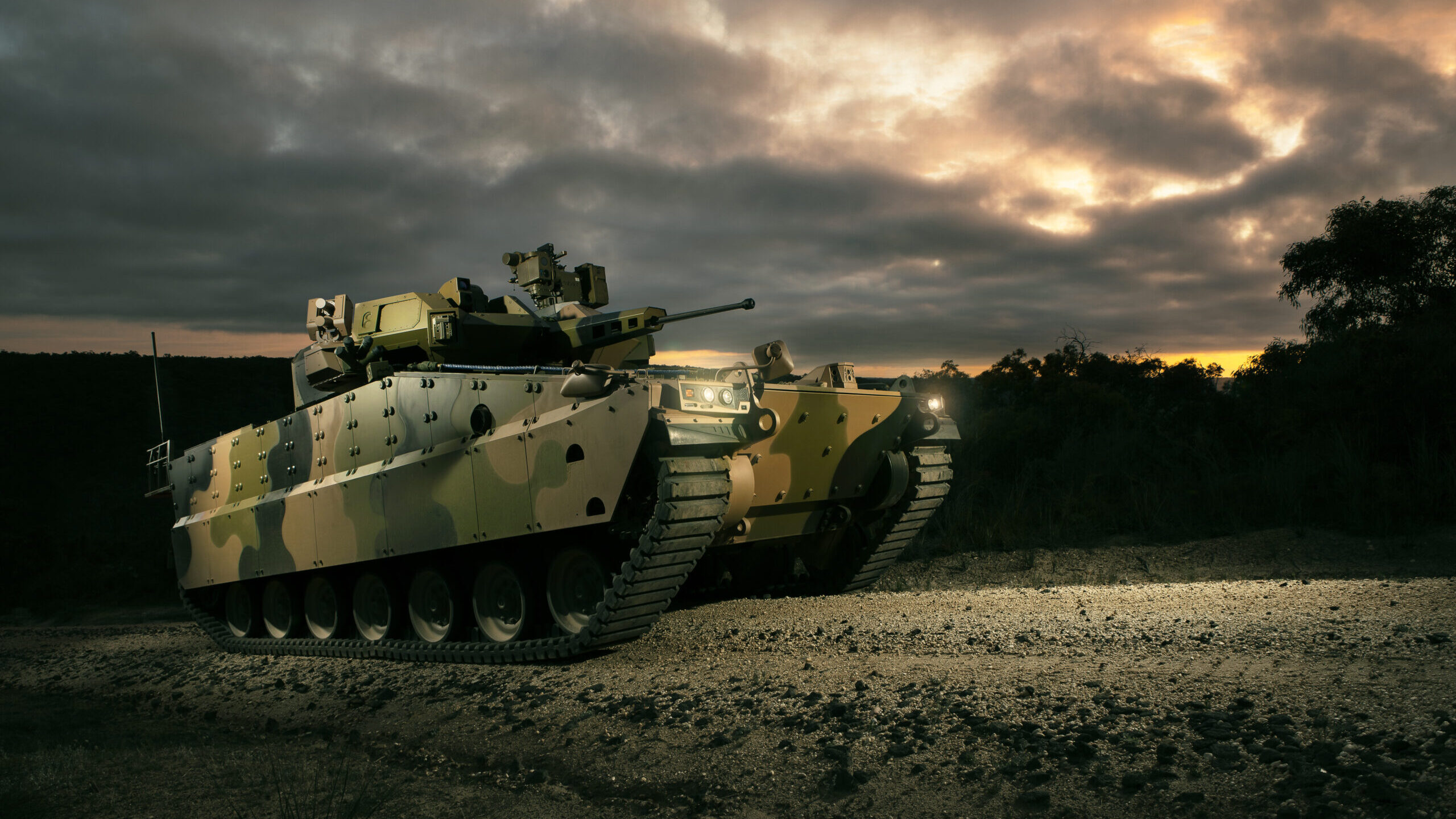
Other partners for OMFV include Pratt Miller Defense, QinetiQ, and Plasan. These firms contribute expertise in vehicle engineering, digital design, C5ISR and autonomy, and in Plasan’s case, vehicle survivability solutions. Oshkosh promises a very high degree of automation of most on-board systems, to reduce the cognitive burden of the crew as well as the logistical burden of the brigade.
Point Blank Enterprises
Point Blank Enterprises, which has no previous experience in vehicle production but has developed vehicle and helicopter armour solutions, touts its experience in leading teams consisting of numerous other firms. PBE’s primary OMFV partner is Keshik Mobile Power Systems, although the firm also refers to a large number of additional (but unspecified) specialised contractors. Point Blank has selected the Cummins Advanced Combat Engine (ACE) to power the OMFV. The PBE website states that the vehicle has a “clean-sheet design engineering with a fully modular technology-agnostic approach,” but overall, the firm has been least forthcoming regarding details of its design concept.
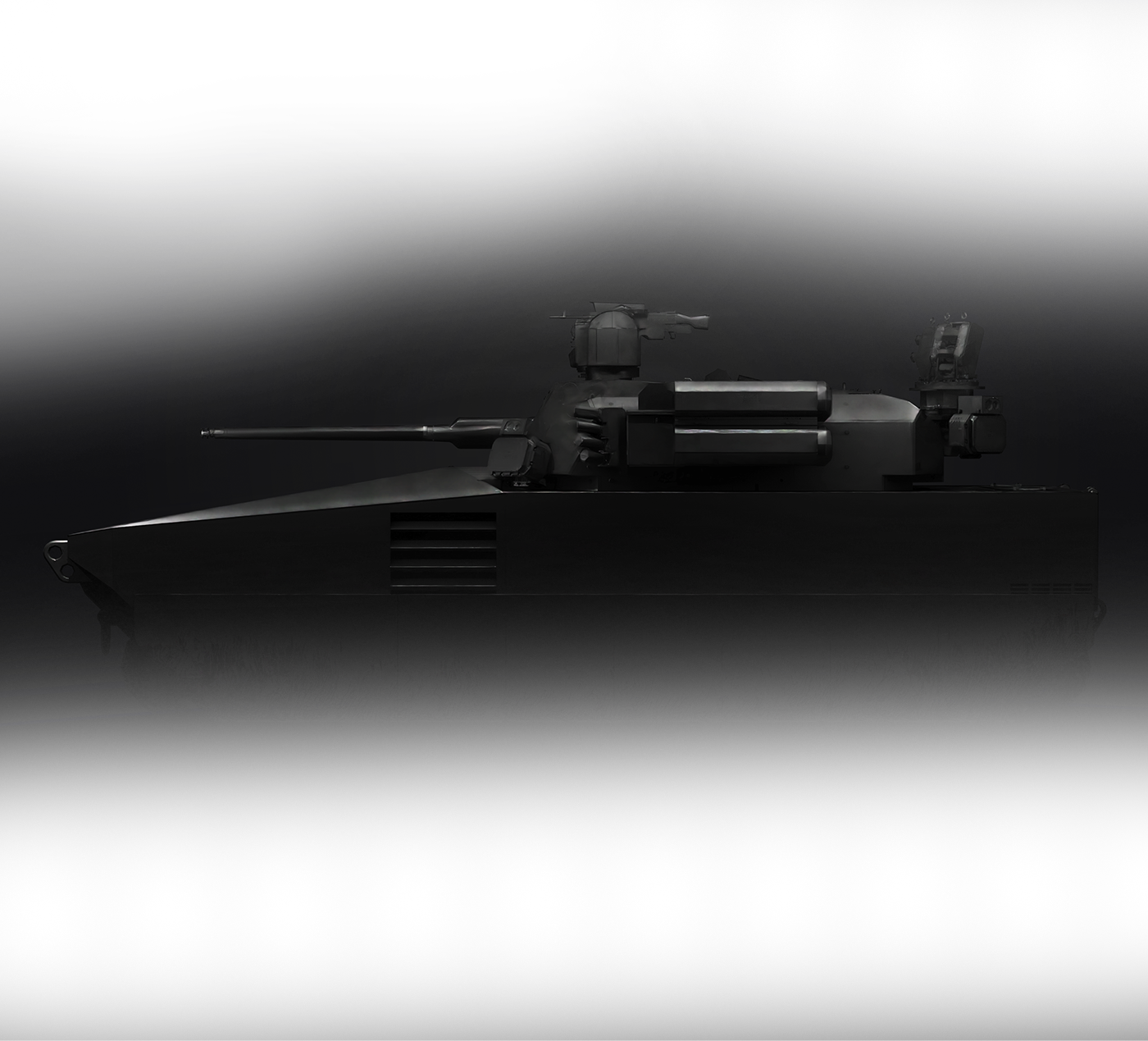
Timeline Moving Forward
As previously noted, the Army plans to downselect to three competing designs in the second quarter (Q2) of FY2023. The three contract awards will simultaneously cover both Phase 3 and Phase 4 of the OMFV program, with the same vendors automatically being chosen for both segments of the program.
Detailed Design Phase
The Detailed Design Phase (Phase 3) will run for 18 months. The preliminary designs will undergo further development, culminating in late FY 2024 with a Comprehensive Design Review (CDR). The CDR will determine whether prototype designs meet baseline requirements and demonstrate technical maturity and manufacturing viability.
Prototype Build and Test Phase
Designs which pass the CDR will enter the 36-month long Phase 4 of the program, which runs from Q1 of FY2025 through Q4 of FY2027. Each participating industry team will be required to submit between seven and eleven physical prototypes of the production-model design, plus two ballistic hulls and turrets, armour coupons, and digital engineering data. The vehicle prototypes will be tested and evaluated against the Army’s OMFV performance specifications. A Limited User Test (LUT) will be conducted late during Phase 4.
Production and Fielding
One of the three competing designs is expected to be selected for acquisition at the end of FY2027. The award of the Low Rate Initial Production (LRIP) contract will initiate Phase 5 of the OMFV programme. Following rigorous operational testing of the first production vehicles, the Army expects to equip the first mechanized infantry unit during FY2029. A full-rate production (FRP) decision is expected in Q2 of FY2030. Procurement is expected to run for two decades. The total value of the contract award, over time, could come to USD 45 Bn.
Sidney E. Dean





